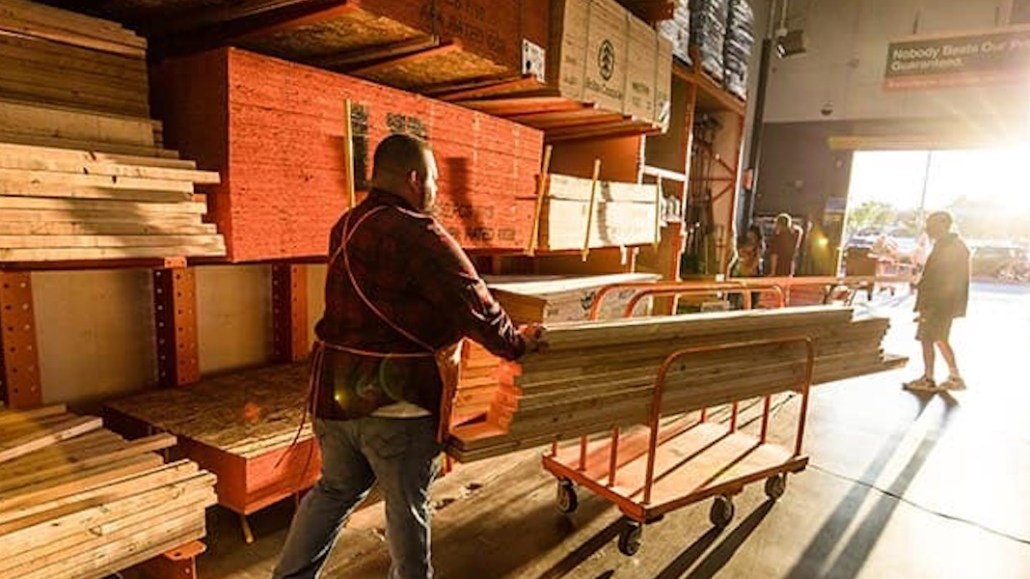
Home Depot is installing online order pickup lockers, in-store navigation tools and digital product information screens to drive customers to physical stores.
Ted Decker, the company’s evp of merchandising, told investors Tuesday that 47 percent of online orders are picked up in stores, illustrative of the fusion of digital and physical customer experiences that he called balancing the “art and science” of retail. The retailer reported that for the second quarter of 2018, online-purchase volume grew 26 percent year over year.
The company said customer experience needs to go beyond having physical stores and e-commerce sites; it needs to cater to customers who want to communicate with the retailer in multiple ways as part of one transaction. For example, customers who buy items online may want to pick them up in stores and talk to associates, building relationships that drive repeat visits. It’s part of a three-year customer experience strategy across Home Depot’s e-commerce sites and physical stores, in which it has reportedly invested $5.4 billion.
Other large retailers pursuing similar approaches include Lowe’s and Walmart. By driving customers to stores, Home Depot can ensure that customers are more comfortable buying expensive products, since they can talk to store employees to get additional advice.
Over the past year, Home Depot has rolled out augmented reality and store-wayfinding capabilities within its mobile app. The retailer is adding in-store pickup for items purchased online, and later this year, it plans to roll out electronic shelf labels for its in-store appliance departments. Through iPad-type screens, customers will be able to review comprehensive product descriptions, said Decker. It’s also investing in improving its supply chain and speeding up delivery and fulfillment capabilities. To this end, Home Depot has rolled out small-parcel express-delivery services from stores in nearly all major U.S. markets, and it plans to open additional fulfillment centers later this year.
The in-store pickup option encourages repeat business, adding opportunities for customers to interact with staff. A recent Credit Suisse research note suggested that the “buy online, pick up in store” service was a major driver of sales growth at Home Depot, and 20-40 percent of these transactions drove sales once the customer visited the store.
Options like “buy online, pick up in store,” and “buy online, deliver from store” have outpaced the growth of direct-to-consumer online sales, according to the report.
The advantage Home Depot has over e-commerce retailers is its trusted in-store employees; furniture and appliance purchases are often daunting for consumers, and delivery can be expensive. In-store pickup can offer opportunities to solve other problems relating to home improvement projects through conversations with associates. But despite advances made by retailers in improving customer service, the race is on among companies to become the default platform for home improvement projects, or the one-stop shop for all things related to the home, said Peter Killian, a partner at Vivaldi.
“When a customer has a home improvement project in mind, who do you think can be the end-to-end solution provider? Home Depot is heading in that direction,” he said.
While retailers are concurrently catering to “do it for me” and “do it yourself” customer groups, they’re increasingly reaching out to a large group that falls between those camps, he added. Amazon and other digital retailers can’t be written out of the mix, but he argues their growth in the furniture space will take longer to solidify than other areas of consumer retail.
For larger retailers like Home Depot, “buy online, pick up in-store” also provides consumers quick access to home improvement supplies, an advantage other retailers should look to when trying to lure more customers.
“In-store pickup is an underrated driver of online conversion for a lot of the larger retailers, but it’s especially critical for Home Depot where a lot of their customers are purchasing bigger, higher-ticket items, or are contractors out on a job looking for a specific supply needed right away,” said eMarketer retail and e-commerce analyst Andrew Lipsman.
On Tuesday, Home Depot reported sales of $30.5 billion for the second quarter of this year, an 8.4 percent year-over-year increase. Same-store sales for the second quarter of 2018 were up 8 percent globally, 8.1 percent in the U.S.
More in Marketing

The definitive Digiday guide to what’s in and out for advertising in 2026
Here’s the definitive guide to what’s in and out in 2026.

‘Less pitching, more listening’: What Amazon is really doing at CES
Amazon’s ad execs come to CES for their annual reality check.

After watching X’s ownership issues play out, marketers brace for TikTok whiplash in 2026
TikTok’s ownership drama has echoes of X (formerly Twitter), but ad performance has kept marketers for fleeing—for now.








